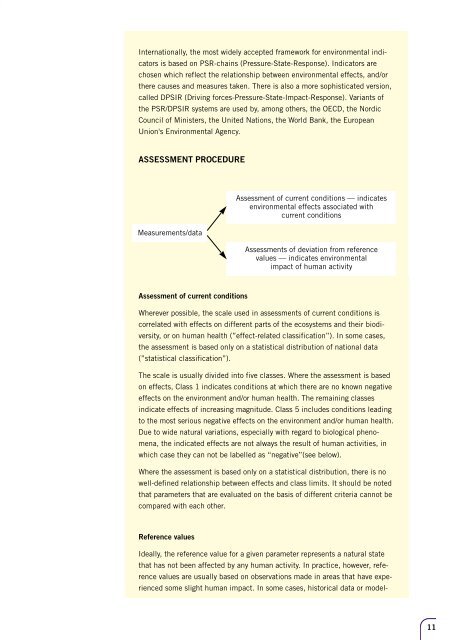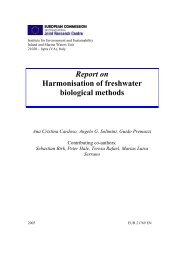Lakes and Watercourses
Lakes and Watercourses
Lakes and Watercourses
You also want an ePaper? Increase the reach of your titles
YUMPU automatically turns print PDFs into web optimized ePapers that Google loves.
Internationally, the most widely accepted framework for environmental indicators<br />
is based on PSR-chains (Pressure-State-Response). Indicators are<br />
chosen which reflect the relationship between environmental effects, <strong>and</strong>/or<br />
there causes <strong>and</strong> measures taken. There is also a more sophisticated version,<br />
called DPSIR (Driving forces-Pressure-State-Impact-Response). Variants of<br />
the PSR/DPSIR systems are used by, among others, the OECD, the Nordic<br />
Council of Ministers, the United Nations, the World Bank, the European<br />
Union's Environmental Agency.<br />
ASSESSMENT PROCEDURE<br />
Measurements/data<br />
Assessment of current conditions — indicates<br />
environmental effects associated with<br />
current conditions<br />
Assessments of deviation from reference<br />
values — indicates environmental<br />
impact of human activity<br />
Assessment of current conditions<br />
Wherever possible, the scale used in assessments of current conditions is<br />
correlated with effects on different parts of the ecosystems <strong>and</strong> their biodiversity,<br />
or on human health (”effect-related classification”). In some cases,<br />
the assessment is based only on a statistical distribution of national data<br />
(”statistical classification”).<br />
The scale is usually divided into five classes. Where the assessment is based<br />
on effects, Class 1 indicates conditions at which there are no known negative<br />
effects on the environment <strong>and</strong>/or human health. The remaining classes<br />
indicate effects of increasing magnitude. Class 5 includes conditions leading<br />
to the most serious negative effects on the environment <strong>and</strong>/or human health.<br />
Due to wide natural variations, especially with regard to biological phenomena,<br />
the indicated effects are not always the result of human activities, in<br />
which case they can not be labelled as “negative”(see below).<br />
Where the assessment is based only on a statistical distribution, there is no<br />
well-defined relationship between effects <strong>and</strong> class limits. It should be noted<br />
that parameters that are evaluated on the basis of different criteria cannot be<br />
compared with each other.<br />
Reference values<br />
Ideally, the reference value for a given parameter represents a natural state<br />
that has not been affected by any human activity. In practice, however, reference<br />
values are usually based on observations made in areas that have experienced<br />
some slight human impact. In some cases, historical data or model-<br />
11















![Accommodation booking form [PDF]](https://img.yumpu.com/39471785/1/184x260/accommodation-booking-form-pdf.jpg?quality=85)

